
Why the Discovery Phase Saves Your Software Project (and Budget)
September 12, 2025 / Bryan Reynolds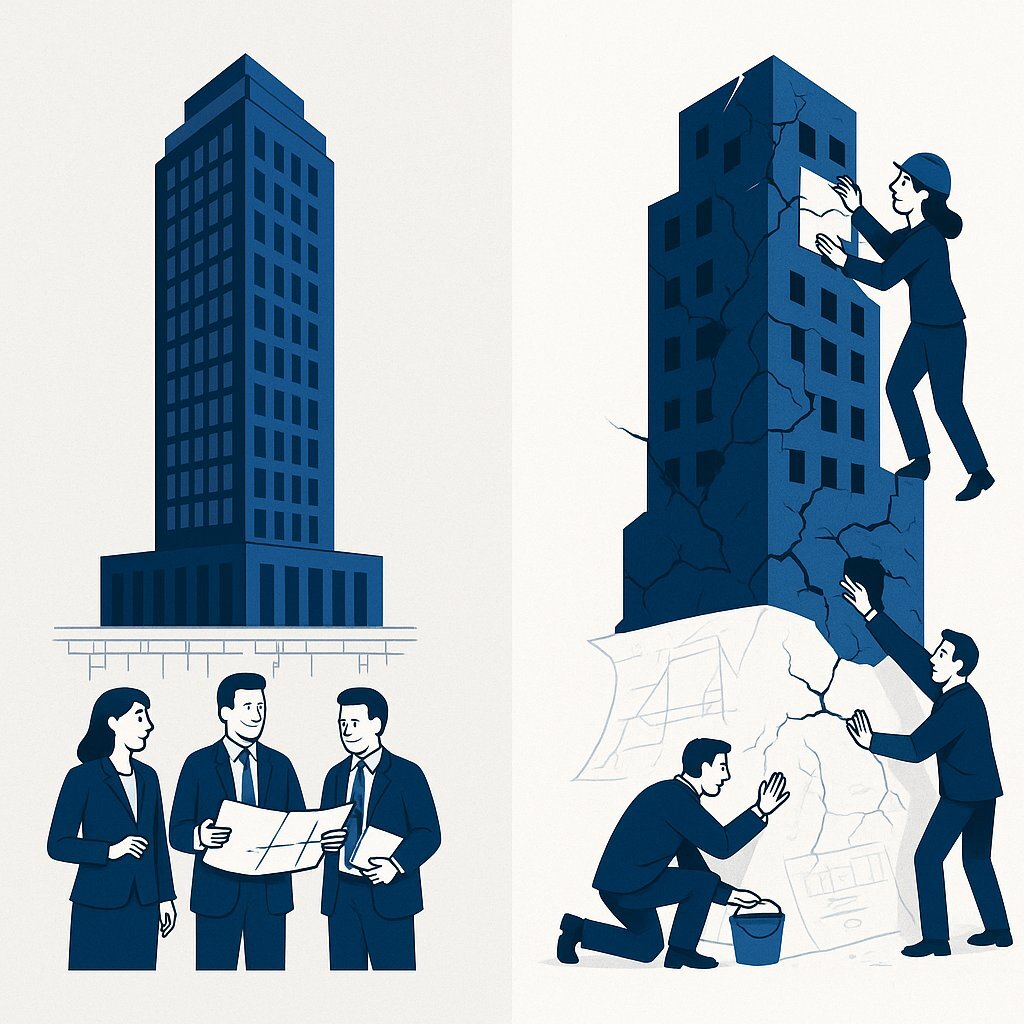
The Blueprint for Success: Why Skipping the Discovery Phase is the Most Expensive Mistake in Software Development
In the high-stakes world of corporate technology investment, few statistics are as sobering as those surrounding IT projects. According to a landmark study by McKinsey, 45% of projects run over budget, and a staggering 17% go so badly they can threaten the very existence of the company. Faced with these odds, the executive impulse is often to accelerate, to push for tangible progress, to get developers coding immediately. This rush to action, however, is a high-risk gamble. It treats software development like a sprint when it should be approached like architecture: you wouldn't build a skyscraper on an un-surveyed plot of land with a back-of-the-napkin sketch.
Yet, countless organizations do the digital equivalent every year, diving headfirst into complex development cycles with only a vague understanding of the true requirements, technical hurdles, and market realities. The result is a predictable pattern of missed deadlines, budget overruns, and, all too often, a final product that fails to deliver its promised value.
There is a strategic, calculated alternative. It is a process that transforms a raw idea into a validated, actionable blueprint before the bulk of a project's budget is committed. This is the Discovery Phase. It is not an optional prelude or a costly delay; it is the single most critical investment in ensuring a software project delivers on its promise. For custom software development firms like Baytech Consulting, the Discovery Phase isn't just a best practice; it's the core mechanism for aligning technology with business outcomes and safeguarding client investments. This report will unpack what this critical phase entails, why it is a strategic imperative for business success, and why, from a purely financial standpoint, it generates an unparalleled return on investment.
What Exactly is a Software Project Discovery Phase?
At its core, the Discovery Phase is a structured, intensive investigation that aligns a project's business goals with market reality and technical feasibility. It is the formal process of de-risking a software initiative by systematically answering the most fundamental questions: What problem are we solving? Who are we solving it for? How will we solve it? And what does success look like? It is the methodical transformation of a business concept into a detailed, validated, and executable plan.
This process is far more than a simple planning meeting. It is a collaborative, multi-disciplinary engagement that brings together a specialized team to examine the project from every conceivable angle.
The Cross-Functional Discovery Team
A successful discovery is a team sport, assembling experts whose combined perspectives ensure no detail is overlooked. The typical team composition demonstrates the depth and seriousness of the undertaking:
- Business Analyst (BA): The BA serves as the crucial bridge between the business's strategic objectives and the technical team's execution. Through stakeholder interviews and workshops, they elicit and document requirements, analyze market conditions, and translate high-level business needs into the precise functional specifications that developers will build against. The BA is responsible for defining the "what" and the "why" of the project.
- Solution Architect: This individual is the master technical strategist. The Solution Architect analyzes the existing technology ecosystem, evaluates potential platforms and frameworks, and designs a high-level system architecture that is scalable, secure, and maintainable. They determine the optimal technology stack and ensure the project is technically feasible, answering the critical question of "how" the solution will be built.
UX/UI Designer: As the advocate for the end-user, the UX/UI designer's role is to ensure the final product is not just functional, but intuitive, efficient, and even enjoyable to use. They conduct user research to understand pain points and behaviors, create detailed user personas and journey maps, and build wireframes and interactive prototypes. Their work ensures the product is fundamentally
usable and solves real-world problems for the people who will interact with it daily.
- Project Manager (PM): The PM is the orchestrator of the entire discovery process. They facilitate communication between the client and the technical team, plan the scope of work, manage stakeholder expectations, and ensure that the process culminates in a comprehensive set of clear, actionable documentation.
Key Activities: How It's Done
The work of this cross-functional team is organized around a series of structured activities designed to extract information, validate assumptions, and build consensus:
- Stakeholder Workshops & Interviews: The process begins by gathering insights from every party with a vested interest in the project's outcome. This includes C-suite executives, department heads, senior managers, and the end-users who will operate the software. These sessions are designed to define what a successful outcome looks like, establish key performance indicators (KPIs), and align the project's goals with the organization's broader strategic objectives.
- Market & Competitor Analysis: No product exists in a vacuum. The team conducts thorough research into the competitive landscape, identifying the strengths and weaknesses of existing solutions—often employing a level of rigor seen in approaches such as those described in evaluations of no-code and SaaS platforms. This analysis uncovers gaps in the market and helps define a unique value proposition, ensuring the final product is not just a "me-too" solution but a genuine competitive differentiator.
- User Research & Persona Development: Moving beyond internal assumptions, the discovery team engages directly with the target audience through interviews, surveys, and observation. This research is synthesized into detailed user personas—archetypes of key user groups—which serve as a constant reference point throughout the project, ensuring that every design and development decision is grounded in the real needs of users. This is the essence of a user-centered design approach.
- Prototyping & Validation: Perhaps the most powerful activity in the discovery phase is the creation of tangible, clickable prototypes. These are not fully functional applications but interactive mockups that allow stakeholders and users to see, feel, and test the proposed solution's flow and interface. This allows for rapid, inexpensive feedback and iteration, ensuring the core concepts are validated before a single line of code is written.
The discovery process, through its structured questioning and diverse stakeholder engagement, often yields a benefit that transcends the software project itself. It functions as a powerful diagnostic for the business. By bringing leaders from different departments—sales, marketing, operations, finance—into the same room, the discovery workshop forces a conversation about priorities and definitions of success. Sales may prioritize a feature for lead generation, while operations needs a feature for efficiency. The discovery process compels these groups to negotiate and forge a single, unified vision for the project. The resulting project documentation, therefore, is more than a technical specification; it is the codification of a new, hard-won internal consensus on a key strategic initiative.
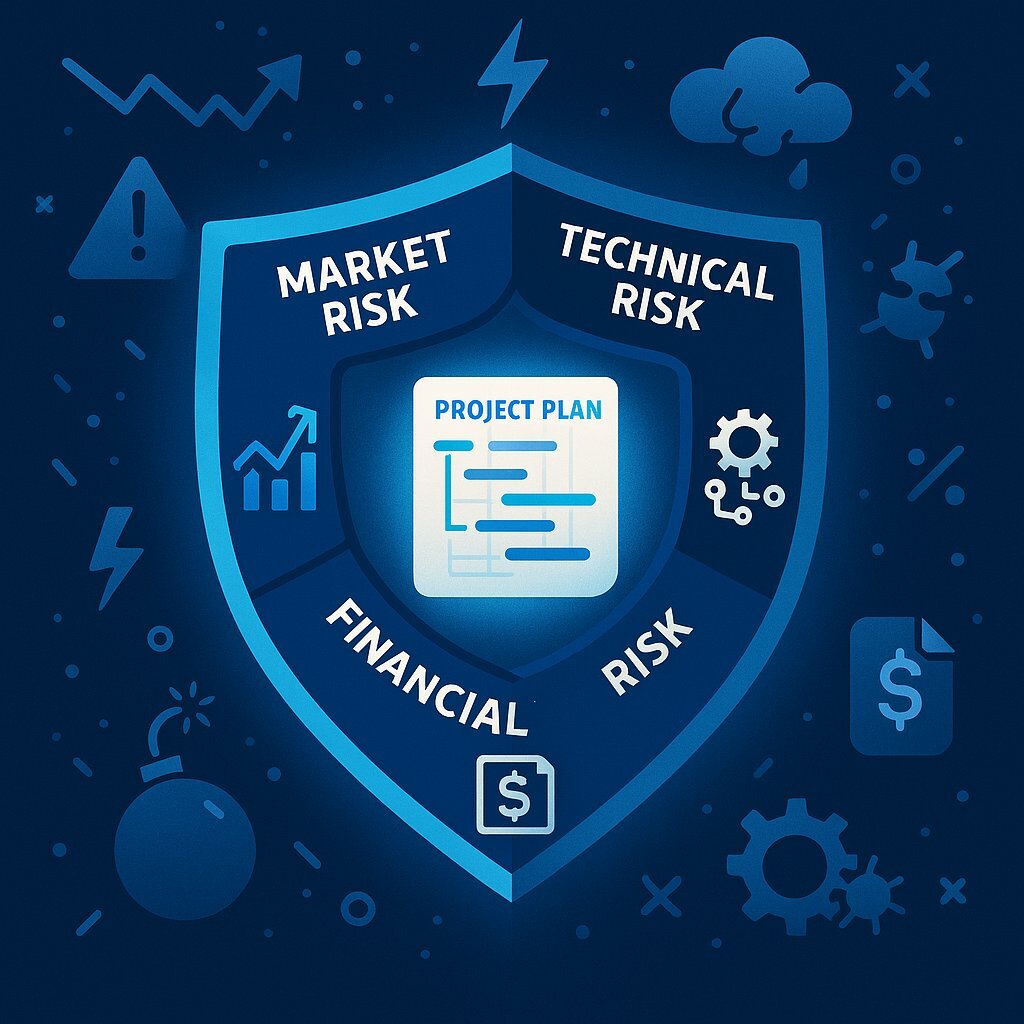
The Strategic Imperative: Why Discovery is Crucial for Business Success
Viewing the discovery phase merely as a planning exercise is to miss its profound strategic importance. It is the primary mechanism by which a company can de-risk a significant capital investment, enforce budgetary discipline, and dramatically increase the probability of achieving product-market fit.
De-Risking Your Investment
Every software project carries inherent risks. The discovery phase is a systematic process for identifying and neutralizing these risks at the point where it is cheapest and easiest to do so.
- Market Risk: The single greatest risk is building a product that nobody wants or needs. Discovery validates the core business idea against real market demand, ensuring the organization doesn't invest millions in a solution searching for a problem.
- Technical Risk: A brilliant concept can be derailed by unforeseen technical complexities. The solution architect's work during discovery confirms that the proposed solution is feasible with current technology, can integrate with existing systems, and can scale to meet future demand.
- Financial Risk: Vague requirements lead to vague estimates. By producing a detailed project scope and technical plan, discovery enables the creation of a high-confidence budget and timeline, transforming the project from a potential "money pit" into a predictable and manageable financial undertaking.
The Antidote to Scope Creep
"Scope creep"—the uncontrolled expansion of a project's features and functions—is one of the most common and destructive forces in software development. It is almost always a symptom of a failed or non-existent discovery phase. When requirements are poorly defined at the outset, it becomes easy for stakeholders to add "just one more thing" throughout the development process.
The discovery phase is the definitive antidote. First, it produces a meticulously defined and documented project scope that is agreed upon by all stakeholders, creating a clear baseline for what is included in the project—and what is not. Second, and more importantly, it establishes a formal
change management process. This framework dictates that any new feature request must be formally submitted and analyzed for its impact on the project's timeline, budget, and resources. This forces a deliberate business decision. The question is no longer "Can we add this feature?" but rather "Is this feature valuable enough to justify the additional $50,000 and two-week delay it will cause?" This discipline, which firms like Baytech Consulting build into their project governance, is essential for protecting the client's budget and timeline.
Building the Right Product, Not Just a Product
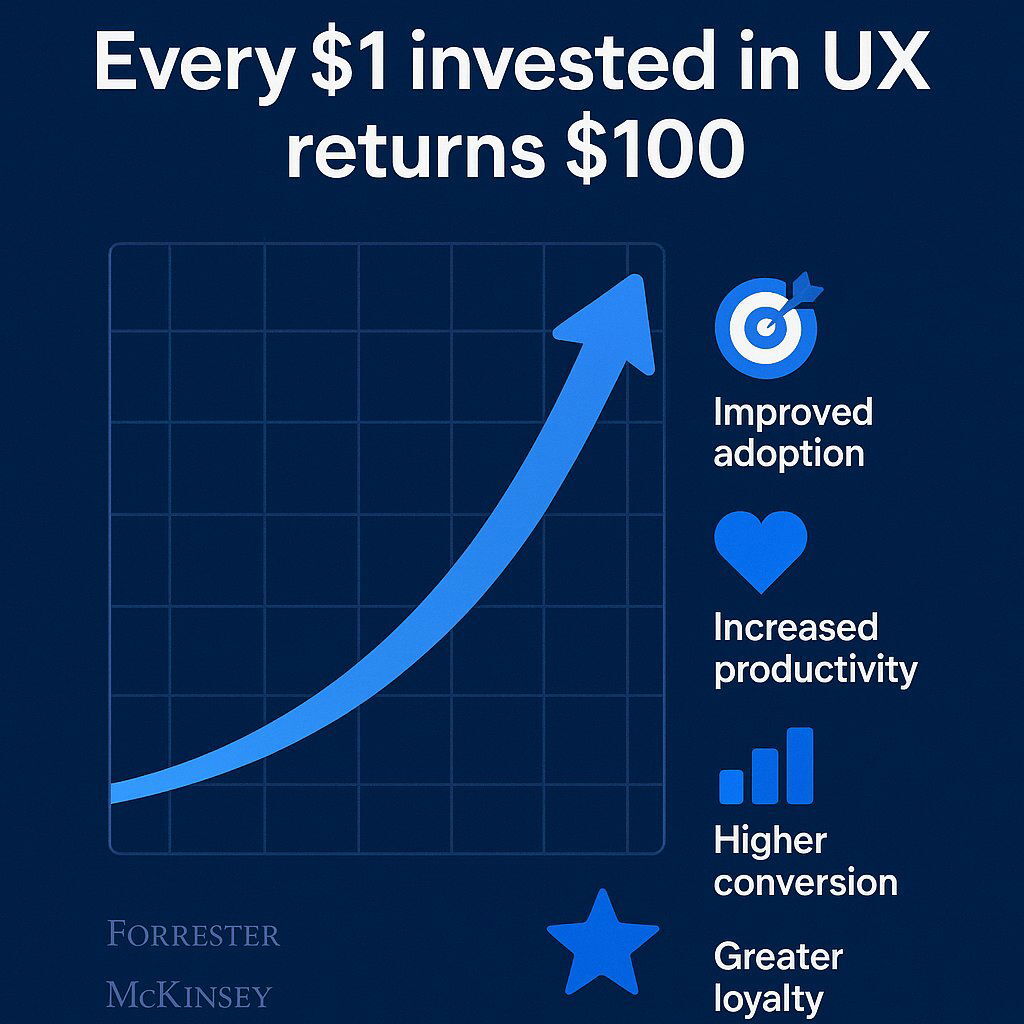
Ultimately, the goal of any software project is to create value, whether by increasing revenue, improving efficiency, or enhancing customer satisfaction. The discovery phase is the mechanism that ensures the project is laser-focused on this goal. By embedding a user-centered design (UCD) approach from day one, it shifts the development focus from internal assumptions to validated user needs.
The commercial impact of this shift is staggering. A Forrester study found that a well-designed, user-centric interface can increase conversion rates by as much as 400%. Furthermore, a landmark study by McKinsey revealed that design-driven companies—those that prioritize understanding and serving the end-user—achieve 32% higher revenue and 56% higher total returns to shareholders over five years. These are not soft metrics; they are hard financial results that stem directly from the principles and activities central to the discovery phase.
Beyond the project itself, the detailed documentation produced during discovery—such as the Software Requirements Specification (SRS)—becomes a critical strategic asset for governance. This mutually agreed-upon "source of truth" serves as a contractual baseline for the entire engagement. When inevitable questions or disagreements arise during development, discussions are not based on fallible memory or subjective opinion. Instead, both the client and the development partner can refer to the signed-off documentation, transforming a potentially contentious debate into an objective contract review. This framework depersonalizes conflict and provides a robust governance structure, which is invaluable for any executive overseeing a complex, high-value project.
The Bottom Line: Is a Discovery Phase Worth the Upfront Cost?
The most common objection from executives is straightforward: "Why should I pay for weeks of planning when those funds could be used for actual development?" It is a valid question that stems from a desire for efficiency. However, the data overwhelmingly shows that skipping discovery is a classic case of being "penny wise and pound foolish"—an attempt to save a small amount upfront that results in catastrophic costs down the line.
The Exponential Cost of Fixing Errors
The financial case for discovery is best illustrated by the "Rule of Ten," a long-standing principle in software engineering. It states that the cost to fix an error increases by an order of magnitude (10x) for each stage of the development lifecycle it passes through undetected. An issue that is a simple correction in a document during discovery becomes a complex and expensive problem once it is baked into the final product.
The following table, compiled from data from IBM and other industry studies, visualizes this dramatic cost escalation.
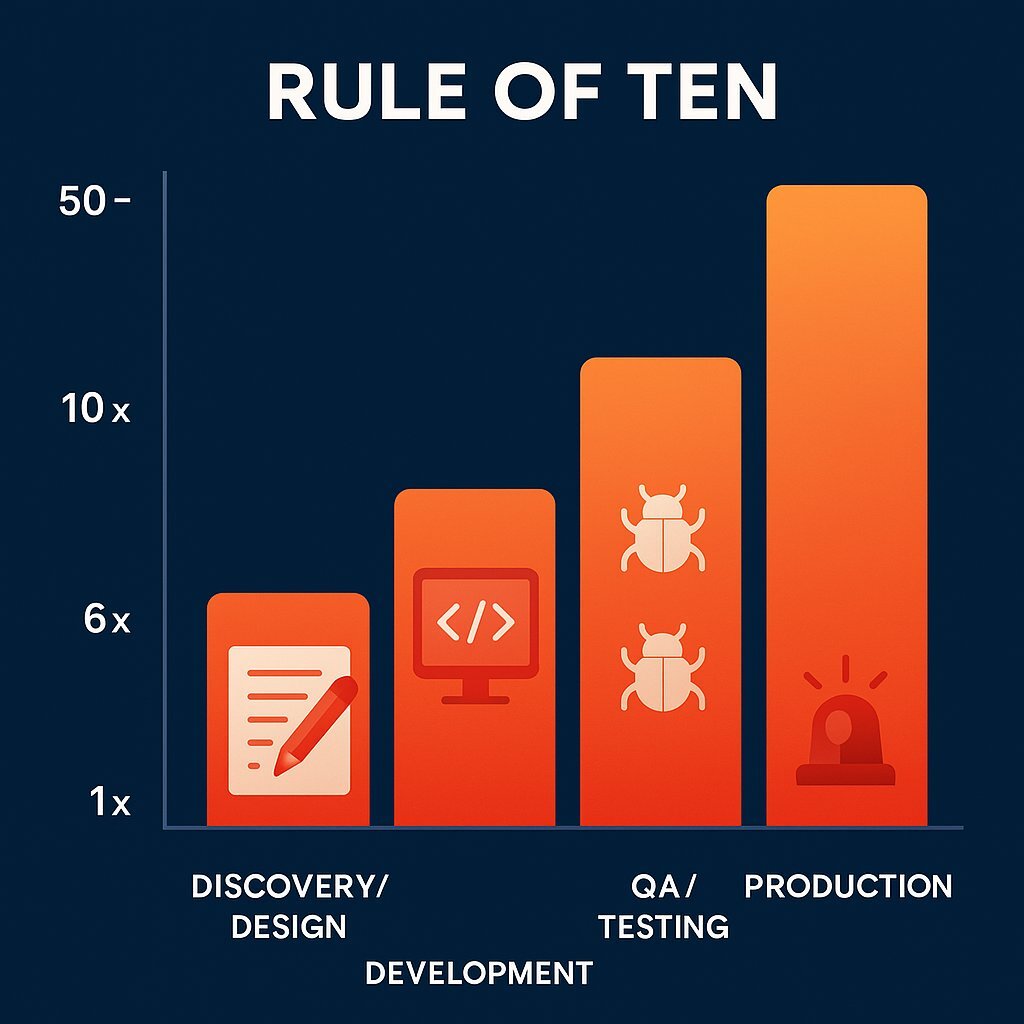
| Stage Defect is Found | Relative Cost to Fix (Source: IBM, Industry Studies) | Business Impact |
|---|---|---|
| Discovery / Design | 1x (Baseline) | A simple change to a document or wireframe. Minimal cost. |
| Development | ~6x | Requires a developer to stop new work, find the bug, rewrite code, and re-test. |
| QA / Testing | ~15x | Involves multiple team members: QA to report, PM to triage, Dev to fix, QA to re-verify. Halts testing progress. |
| Production (Post-Launch) | 50x - 100x+ | Catastrophic cost. Involves emergency patches ("hotfixes"), potential system downtime, lost revenue, customer support overload, brand damage, and potential data security breaches. |
This exponential curve is not theoretical. A NASA study on project costs found that projects that spent less than 5% of their total budget on the requirements process experienced cost overruns of 80% to 200%. Conversely, those that invested 8% to 14% in this upfront work saw significantly lower overruns. Other studies confirm the root of the problem: 39% of project failures are attributed to poor requirements gathering, and 50% suffer from the scope creep that a proper discovery phase is designed to prevent.
The ROI of Good Design
Beyond cost avoidance, discovery drives significant value creation for organizations actively engaging in secure, DevSecOps-oriented software projects. The user experience (UX) research and prototyping activities are central to the process. As cited earlier, Forrester research indicates that every $1 invested in UX returns $100. This represents a staggering ROI of 9,900%. This return is realized through higher user adoption, increased productivity, better conversion rates, and greater customer loyalty—all direct outcomes of building a product that is designed around the user from the very beginning.
At Baytech Consulting, this financial reality is observed in project after project. The discovery phase typically represents 5-10% of the total project cost, but it consistently mitigates risks that could otherwise lead to budget overruns of 50% or more. It is, without question, the highest-leverage investment one can make in the entire project lifecycle.
From Ambiguity to Action: The Key Deliverables of a Discovery Phase
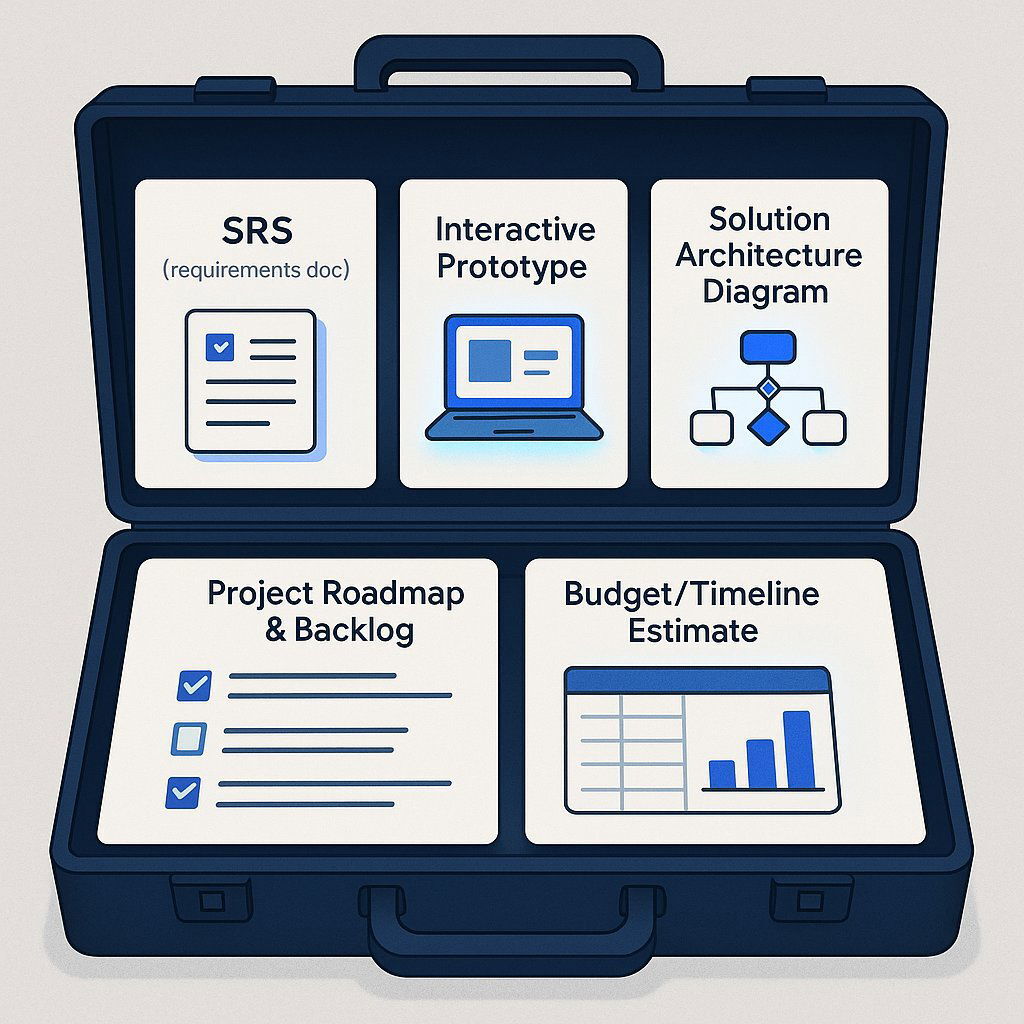
A well-executed discovery phase does not end with a series of conversations and a handshake. It culminates in the delivery of a package of tangible, high-value strategic assets that form the immutable foundation for the entire development project. These deliverables provide clarity, alignment, and a detailed roadmap for everyone involved, from the CFO to the junior developer.
Key deliverables include:
- Software Requirements Specification (SRS): This is the comprehensive project blueprint. The SRS is a detailed document that outlines every functional requirement (what the system must do) and non-functional requirement (e.g., performance, security, scalability). It leaves no room for ambiguity and serves as the definitive "source of truth" for the development team.
- Interactive Prototype: A clickable, visual model of the application that allows stakeholders to experience the user flow and interface firsthand. This is an invaluable tool for gathering early feedback, securing buy-in from leadership, and can even be used to demonstrate the product concept to potential investors to secure funding.
- Solution Architecture Diagram: This high-level technical plan visually represents the system's structure, the chosen technology stack, data models, and key integration points. It provides assurance that the technical foundation is robust, scalable, and secure.
- Project Roadmap & Backlog: This deliverable provides a strategic timeline with clearly defined phases and milestones, offering a transparent view of the development journey. It is accompanied by a prioritized product backlog—a list of all features to be built, ordered by business value—which ensures that the most important functionality is delivered first.
- High-Confidence Budget and Timeline: For the executive suite, this is one of the most critical outputs. The discovery process allows the team to move from a rough, "ballpark" estimate to a detailed, evidence-based financial plan and delivery schedule. This provides the predictability necessary for effective capital planning and resource allocation.
Crucially, these deliverables are valuable, standalone assets owned by the client. This offers a significant strategic advantage. Even if an organization chooses not to proceed with the development phase, or decides to work with a different partner, they possess a complete, professional-grade project blueprint. This dramatically de-risks the initial engagement. It allows a company to make a smaller, contained investment to "try before you buy," assessing a potential development partner's expertise, communication, and strategic thinking. If the partnership is a good fit, the project proceeds with confidence. If not, the investment is not lost; the client has acquired a powerful asset that can be used to solicit more accurate, competitive bids from other vendors, ensuring the project starts on the right foot, regardless of the implementation partner.
Conclusion
The evidence is unequivocal. The Discovery Phase is not a cost center; it is a profit center. It is the strategic fulcrum that leverages a small, upfront investment to prevent massive downstream costs, mitigate project-killing risks, and ensure the final product achieves its intended business goals. It is the disciplined process of asking and answering the hard questions at the beginning, when the cost of change is measured in hours of discussion, not months of rework.
In today's hyper-competitive market, building software on a foundation of assumptions is a strategic liability. A rigorous Discovery Phase, the kind championed by the experts at Baytech Consulting, transforms that liability into an asset. It ensures your next technology investment is not a leap of faith, but a calculated, data-driven strategy for sustainable growth.
Supporting Links
- https://www.nngroup.com/articles/user-centered-design/
- https://www.cio.com/article/2438098/project-management-how-to-calculate-roi-for-your-it-projects.html
- https://www.pmi.org/standards/requirements-management
About Baytech
At Baytech Consulting, we specialize in guiding businesses through this process, helping you build scalable, efficient, and high-performing software that evolves with your needs. Our MVP first approach helps our clients minimize upfront costs and maximize ROI. Ready to take the next step in your software development journey? Contact us today to learn how we can help you achieve your goals with a phased development approach.
About the Author

Bryan Reynolds is an accomplished technology executive with more than 25 years of experience leading innovation in the software industry. As the CEO and founder of Baytech Consulting, he has built a reputation for delivering custom software solutions that help businesses streamline operations, enhance customer experiences, and drive growth.
Bryan’s expertise spans custom software development, cloud infrastructure, artificial intelligence, and strategic business consulting, making him a trusted advisor and thought leader across a wide range of industries.


